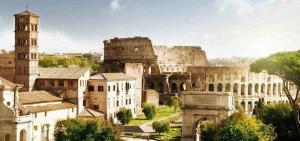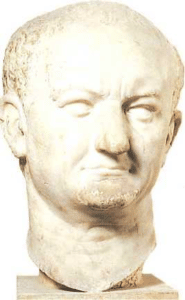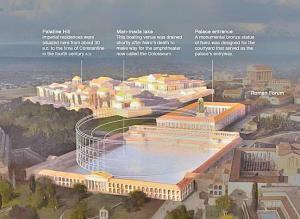|
Viewers have called this documentary "mind-blowing", and we agree. The Roman Colosseum was a technological marvel in its own right, even if its purposes were most of the time simply decadent and sanguinary, if not outright revolting. The Colosseum remains a symbol for a complex culture, and a warning to contemporary humanity about the outer limits of absolute power. Let's keep in mind Julius Cesar, perhaps the most famous and illstrious of Romans, never saw the Colosseum. He had been assassinated in 44 BC, almost 120 years before the great buildng was inaugurated.
The Romans were truly amazing engineers and builders every thing they did 2000 years ago we mimic today they were the true builders of the future an amazing race destroyed by power and greed, just like the world today.??
Colosseum History: IntroductionOn the east of the Roman Forum, the enormous stone amphitheater known as the Colosseum was built around A.D. 70-72 by Emperor Vespasian of the Flavian dynasty as a gift to the Roman citizens. In A.D. 80, Vespasian’s son Titus opened the Colosseum; formally referred to as the Flavian Amphitheater; with 100 days of games, consisting of gladiatorial combats and wild animal fights. After 4 centuries of active usage, the magnificent arena fell into disregard, and up until the 18th century it was utilized as a source of building elements. Though two-thirds of the original Colosseum has been damaged with time, the amphitheater stays a popular tourist location, in addition to a renowned symbol of Rome and its long, troubled history. 
The Colosseum was built between 72 A.D and 80 A.D under the Roman Emperor Vespasian, in the heart of Rome. Colosseum History: Construction Planning
Portrait head of Vespasian ftom Ostia, Rome, Museo Nazionale Romano Construction was begun by Vespasian and finished by Titus in A.D. 80 with a solemn inauguration lasting all of one hundred days, which is recorded in ancient chronicles. As a gigantic monument to the gladiatorial spectacles that were extremely popular in the Roman world and directed to praising the generosity of the emperors who had conceived it, the Colosseum was without doubt the Flavians’ most ambitious and demagogic political project. In A.D. 64, a terrible fire destroyed Rome. It burned for nine days until it was finally put out. When the Emperor Nero rebuilt the city, he saved a huge area in the center for a new palace. In the entrance of the Golden House, there was a huge statue, of the emperor himself. It was 37 m high and made of bronze. Outside, Nero had a private park with a lake. 
Colosseum was to be built on the site of Nero’s lake. Nero had built an aqueduct to carry water into his artificial lake. To drain it, the builders cut this supply of water. Photo Credit: National Geographic. Romans hated the Golden House. Nero was known to have murdered his mother, his wife, and his stepbrother. People were suspicious of him starting the blaze. Nero had almost moved into his new home when he learned of widespread uprisings against his rule. The generals commanding Rome’s greatest armies refused to obey Nero’s orders, saying that they would make better emperors themselves. Abandoned by everyone, Nero killed himself. 18 months of war came out after Nero’s death as rival generals fought each other for power. Respectively, three men became emperor in Rome, (Galba , Otho and Vitellius). By the end of A.D. 69, Vespasian became the new emperor, an old general. In the previous 18 months, four Roman emperors had died. Vespasian did not want to to be the fifth dead emperor. So, he wanted to be loved by the people of Rome. Vespasian decided to pull down most of Nero’s hated Golden House and to open the grounds as a public garden. He also planned to build a huge amphitheater for public show. Emperor Vespasian died before the construction was finished. Colosseum was opened in A.D. 80 by his son, the Emperor Titus. The Romans called their new amphitheater the Flavian Amphitheater, after the family name of Vespasian and Titus. The later name Roman Colosseum comes from the Colossus (Colyseus), the big statue of Nero that stood next to it. It was such an impressive statue that it had not been destroyed by Vespasian, he renamed it as a statue of the sun-god. Under the Empire, the Colosseum was restored several times after fires and earthquakes. There is documentary evidence of work ordered by Antoninus Pius, Heliogabalus and — after a disastrous fire in A.D. 217 — Alexander Severus. Restoration work was also carried out and commemorated by epigraphs subsequent to the earthquake of A.D. 443. After A.D. 523 there is no record of spectacles. A period of decay and ruin began which in a short time transformed the monument into a quarry of building materials.  The Colosseum is the largest amphitheater (meaning “round theatre”) in the world! Oval in shape, it is 189m long (almost 2 city blocks), 156m wide, and 50m high (about the height of a 12 story building). This ancient sporting arena might quickly fit a modern football pitch inside! Who is the Colosseum’s Architect? Nobody knows due to the fact that no engraving tells us his name. The building was erected to the glory of the Flavian Family.
|
[premium_newsticker id="211406"]
This work is licensed under a Creative Commons Attribution-NonCommercial 4.0 International License








Mike Wring 8 months ago